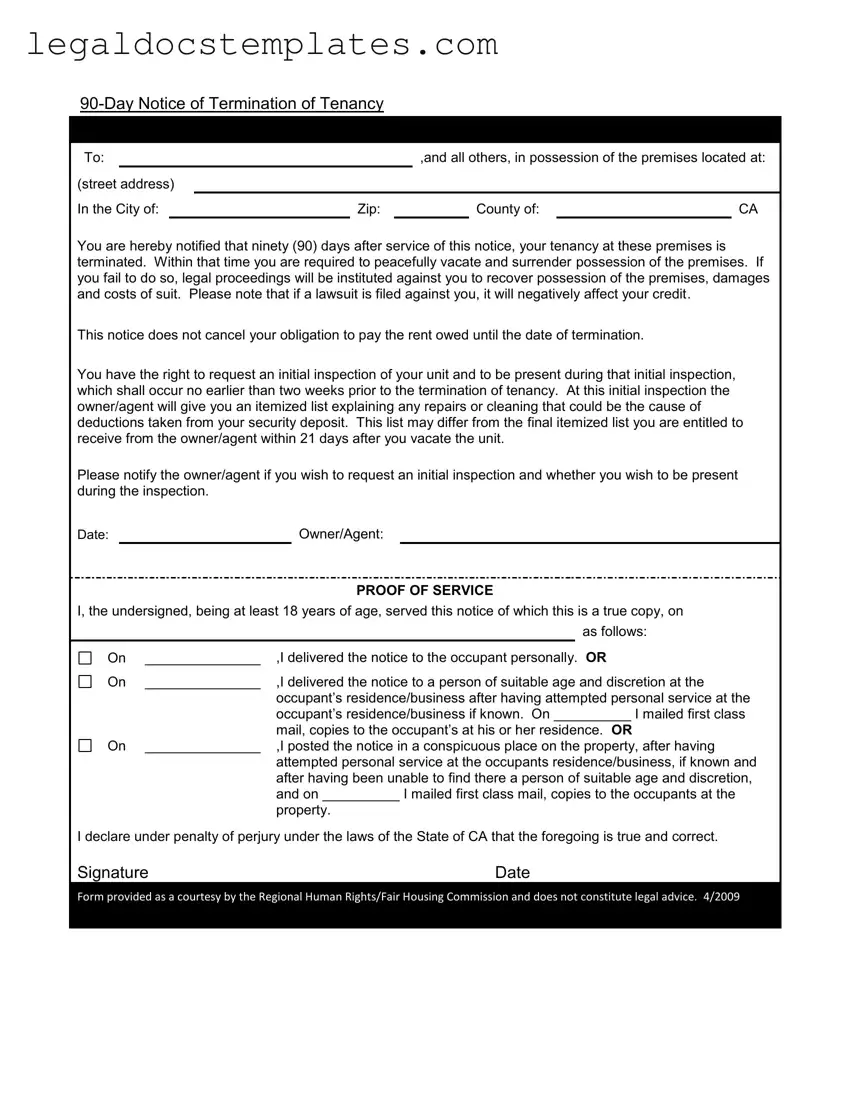The 30-Day Notice to Vacate is akin to the 90-Day Notice To Move Out form as both serve as notifications from landlords to tenants, stating the lease termination and requiring the tenant to leave the property within a set period. While the reasons may vary, their core purpose aligns in informing tenants of the need to vacate. The significant difference lies in the notice period provided, where the former gives a shorter window for tenants to make moving arrangements, potentially used in month-to-month leases or for specific lease violations.
Similarly, the Lease Termination Letter shares common ground with the 90-Day Notice To Move Out form, as it formally communicates the end of a lease agreement. This letter can be initiated by either the landlord or the tenant, depending on the circumstances prompting the lease’s termination. It offers a platform to outline terms under which the lease is ending, including the notice period, often adhering to the stipulated lease terms or state laws.
The Eviction Notice also parallels the 90-Day Notice To Move Out form in its fundamental purpose to initiate the process of removing a tenant from a property. However, eviction notices are typically grounded in the tenant's failure to comply with lease terms, such as non-payment of rent or causing significant damage. The type of notice, such as Pay Rent or Quit or Cure or Quit, specifies the issue and usually provides a shorter remedy period before legal action is taken.
The Notice of Rent Increase is conceptually related to the move-out notice, as it is another form of communication between landlords and tenants about significant changes affecting tenancy. Though it doesn't directly stipulate termination, it informs tenants of upcoming rent adjustments, potentially influencing their decision to renew or terminate their lease, somewhat indirectly prompting a move-out scenario for those unable to accommodate the new rent.
A Property Inspection Notice is another document that, while distinct in purpose, overlaps with the 90-Day Notice to Move Out in involving procedural steps landlords take during tenancy changes. This notice informs tenants of the landlord's intent to enter the property for inspection, which could be related to maintenance, lease compliance, or preparing for the property to be vacated, highlighting the procedural aspect of managing a rental property.
The Security Deposit Return Letter is often a follow-up to the move-out process, detailing the condition of the vacated unit and the handling of the tenant's security deposit. Similar to the move-out notice, this document is critical in lease termination situations, clarifying final financial transactions between the landlord and the tenant, and ensuring compliance with state laws regarding deposit returns.
Conversely, the Tenant's Notice to Vacate flips the perspective, with the tenant initiating the notice to the landlord to end the lease. Like the 90-Day Notice to Move Out form, it's a formal declaration of intent to vacate the property, adhering to lease terms or state laws concerning notice periods. This document empowers tenants to communicate their moving plans or end their lease agreement due to various personal reasons or dissatisfaction with rental conditions.
The Rent Receipt is indirectly associated with the move-out notice through its role in documenting the financial transactions between landlord and tenant during the tenancy. Regular provision of rent receipts can serve as proof of a tenant’s good standing, which could influence negotiations or interactions related to lease termination or compliance with move-out notices.
A Roommate Agreement shares similarity in its foundational aim to clarify terms of cohabitation, potentially playing a part in circumstances leading to a 90-Day Notice to Move Out form being issued. Whether due to roommate conflicts or changes in living arrangements, such agreements help define expectations and responsibilities, setting the stage for smoother transitions should a move-out become necessary.
Last but not least, the Repair Request Form is somewhat connected to the move-out notice as it involves tenant-landlord communication regarding the property's condition. Prompt and documented requests for repairs can affect the tenancy's quality and duration. In situations where repair issues escalate or contribute to the decision to terminate a lease, this form becomes a part of the lease termination and move-out process, emphasizing the importance of maintaining property standards.

